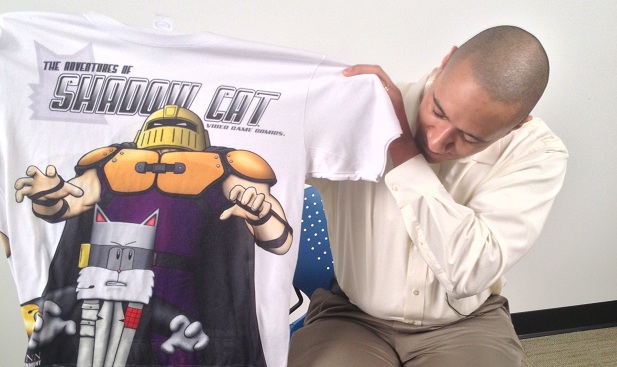In the origin story of The Adventures of Shadow Cat, a motley crew of pals—namely, a snake named Mike and Max the cat—discover a top-secret hidden lab full of gadgets, like a plasma blaster and superhero suit. When Max puts on the suit and grabs the weapon, he becomes Shadow Cat, a superhero tasked with vanquishing the mean gang of felines terrorizing the neighborhood. Unfortunately, he has to deal with pitfalls—such as malfunctioning weaponry—in his quest.
Sounds like a recipe for a buzzworthy comic, right? It sure is—and then some, if Shadow Cat’s creator, Tamar Medina of J-Lynn Entertainment, has his way. In 2010, Cleveland, Ohio, native Medina, a former Electronic Arts employee, had the idea for a product that combined the storyline of a comic book with the interactivity of video games. Naturally, he called them video game comics.
After unveiling this technology to the general public and talking to attendees, he discovered that these video game comics had an unexpected potential side benefit: Besides being fun, they could serve as a valuable learning tool.
“When we tested our concept out at comic book conventions, we would have teachers and parents say, ‘Hey this would be great for kids with autism’ or ‘I have a child with ADHD who’d like this,’” Medina says. Additional research revealed that the product could have positive applications for these audiences.
Medina notes that the visual nature of these stories—as well as the fact that they use technology to read them—is also a plus. “A comic book is basically telling a story through pictures, like a story book,” he says. “Kids with autism love technology; they love playing games. The comic book is automatically good for helping to relate words and meanings, but it also includes that game component.”
Yet J-Lynn Entertainment’s games aren’t just, well, entertainment. Built into the video game comics are analytics that could help parents, teachers, therapists and even researchers monitor a student’s progress. “The type of data that we capture with video game comics is perfect in terms of what researchers and parents are looking for in terms of student performance,” Medina says. “For instance, we can tell how fast a child is reading. If a reader is averaging thirty seconds per panel and all of a sudden he stays on one panel for three minutes, the parent or researcher can go back and look at that panel and figure out [why]. Was it the subject matter? Was it what was in the words? Was the reading level too high?”
J-Lynn Entertainment is currently in the prototyping phase, specifically for mobile and desktop devices. They’re also planning to release a pilot issue of the comic this fall. In the longer term, Medina hopes that Shadow Cat’s adventures will have an even greater reach.
“Our ultimate success is five to seven years from now selling products on a global scale and having youths everywhere sporting Shadow Cat T-shirts,” he says, laughing. “I always think back to when I was a child watching Saturday morning cartoons. They stuck with me as an adult, and we hope to do that for upcoming generations.”
Watch this video for more about Shadow Cat and J-Lynn Entertainment’s video game comics:







